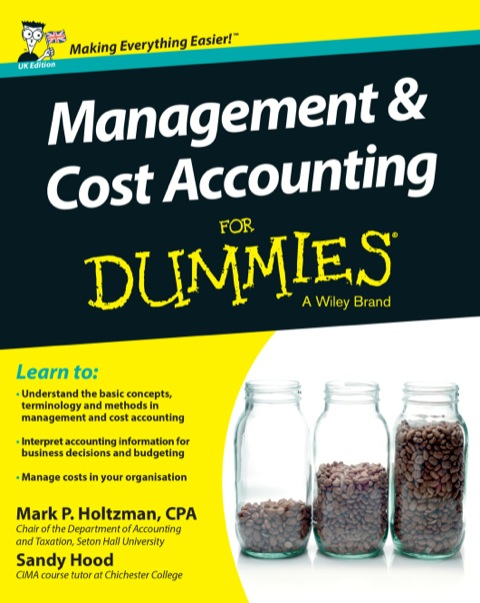Description
Efnisyfirlit
- Contents at a Glance
- Table of Contents
- Introduction
- About This Book
- What You’re Not to Read
- Foolish Assumptions
- How This Book Is Organised
- Icons Used in This Book
- Where to Go from Here
- Part I: Getting Started with Management and Cost Accounting
- Chapter 1: Planning and Control: The Role of Management Accounting
- Understanding What Management Accountants Do, and Why
- Concentrating on Costs
- Accounting for the Future: Planning and Budgeting
- Exercising Control
- Getting Certified
- Chapter 2: Using Management Accounting in Your Business
- Classifying Companies by Their Output
- Measuring Profits
- Meeting the Three Es of Performance
- Putting Profitability and Productivity Together: Return on Capital Employed
- Part II: Understanding and Managing Costs
- Chapter 3: Classifying Direct and Indirect Costs
- Distinguishing Direct from Indirect Manufacturing Costs
- Valuing Inventory of Materials and Finished Goods
- Examining the Treatment of Labour Costs within the Accounting System
- Two Other Ways to Classify Costs
- Chapter 4: Allocating, Apportioning and Absorbing Overhead
- Introducing Budgeting Overhead Costs
- Charging Production Overheads into Products: Traditional Approach
- Taking Advantage of Activity-Based Costing for Overhead Allocation
- Working Through an Example: Rusbridge Limited
- Chapter 5: Costing Products Flowing Through a Business
- Tracking the Flow of Products
- Following the Phases of Production and Sale
- Computing Units Sold
- Chapter 6: Job Costing: Pricing Individual Orders
- Keeping Records in a Job Costing System
- Understanding the Accounting for Job Costing
- Chapter 7: Process Costing: Tracking What’s Produced and How Much it Costs
- Comparing Process Costing and Job Costing
- Maintaining Process-Costing Books
- Demonstrating Process Costing in Action
- Chapter 8: Observing How Variable and Fixed Costs Behave
- Investigating Cost Behaviour
- Separating Semi-variable Costs into Variable and Fixed Components
- Sticking to the Relevant Range
- Part III: Planning and Budgeting
- Chapter 9: Using Contribution Analysis to Make Better Decisions
- Calculating the Contribution
- Meeting Net Profit Targets with Cost-Volume-Profit Analysis
- Bringing up Break-Even Analysis
- Modifying to Achieve a Target Profit
- Feeling Secure: Margin of Safety
- Juggling Variable and Fixed Costs: Operational Gearing
- Chapter 10: Decision-Making within the Reality of Limited Capacity
- Understanding the Reality of Limited Resources
- Focusing on Relevant Costs
- Ignoring Certain Costs Safely: Irrelevant Costs
- Chapter 11: Deciding on Long-Term Purchases: Capital Budgeting
- Identifying Incremental and Opportunity Costs
- Getting Your Money Back: The Payback Technique
- Understanding Time Value of Money and Net Present Value (NPV)
- Putting Payback and NPV into Practice
- Investigating Internal Rate of Return (IRR)
- Looking beyond the Numbers: Qualitative Factors
- Chapter 12: Naming Your Price: Approaches to Decision-Making
- Differentiating Products to Decide on Prices
- Taking All Costs into Account: Absorption Costing
- Pricing at Cost-Plus
- Short-Term Pricing Based on Relevant Costs
- Hitting Your Bull’s-Eye: Target Costing
- Chapter 13: Doing Deals between Company Divisions: Transfer Prices
- Pinpointing the Importance of Transfer Pricing
- Negotiating a Transfer Price
- Transferring Goods between Divisions at Cost
- Positioning Transfer Price at Market Value
- Chapter 14: Planning Budgets for the Future
- Preparing a Manufacturer’s Master Budget
- Applying Master Budgeting to Non-Manufacturers
- Moving Beyond Budgeting
- Part IV: Using Management Accounting for Evaluation and Control
- Chapter 15: Using Flexible Budgets to Exert Control
- Appreciating the Need to Control Your Business
- Dealing with Budget Variances
- Implementing a Flexible Budget
- Chapter 16: Variance Analysis: Flexing Standard Costs
- Setting Up Standard Costs
- Identifying Factors that Give Rise to Variances
- Teasing Out Variances
- Chapter 17: Establishing Accountability with Responsibility Accounting
- Linking Strategy with an Organisation’s Structure
- Identifying Different Kinds of Responsibility Centres
- Chapter 18: The Balanced Scorecard: Reviewing Your Business’s Report Card
- Introducing the Balanced Scorecard: Key to Strategy
- Demonstrating the Balanced Scorecard in Action
- Testing Times: Exam Advice
- Chapter 19: Squeezing Out of a Tight Spot with the Theory of Constraints
- Understanding the Nature of Constraints
- Managing Processes with the Theory of Constraints
- Part V: The Part of Tens
- Chapter 20: Ten Key Management Accounting Formulas
- The Accounting Equation: Working with Assets and Liabilities
- Profit: Focusing on the Bottom Line
- Cost of Goods Sold: Handling Inventory
- Contribution: Measuring the Impact of Decisions on Profit
- Cost-Volume-Profit Analysis: Considering the Effects of Changing Volume
- Break-Even Analysis: Ensuring You Don’t Make a Loss
- Calculating the Effect of Direct Materials Price Variance on Total Cost
- Determining the Effect of Direct Materials Usage Variance on Total Cost
- Future Value: Computing the Value of a Cash Investment
- Present Value: Deciding How Much to Invest
- Chapter 21: Ten Careers in Management Accounting
- Corporate Treasurer
- Chief Financial Officer
- Financial Controller
- Group Accountant
- Financial Analyst
- Cost Accountant
- Budget Analyst
- Internal Auditor
- Fixed-Assets Accountant
- Cash-Management Accountant
- Index





